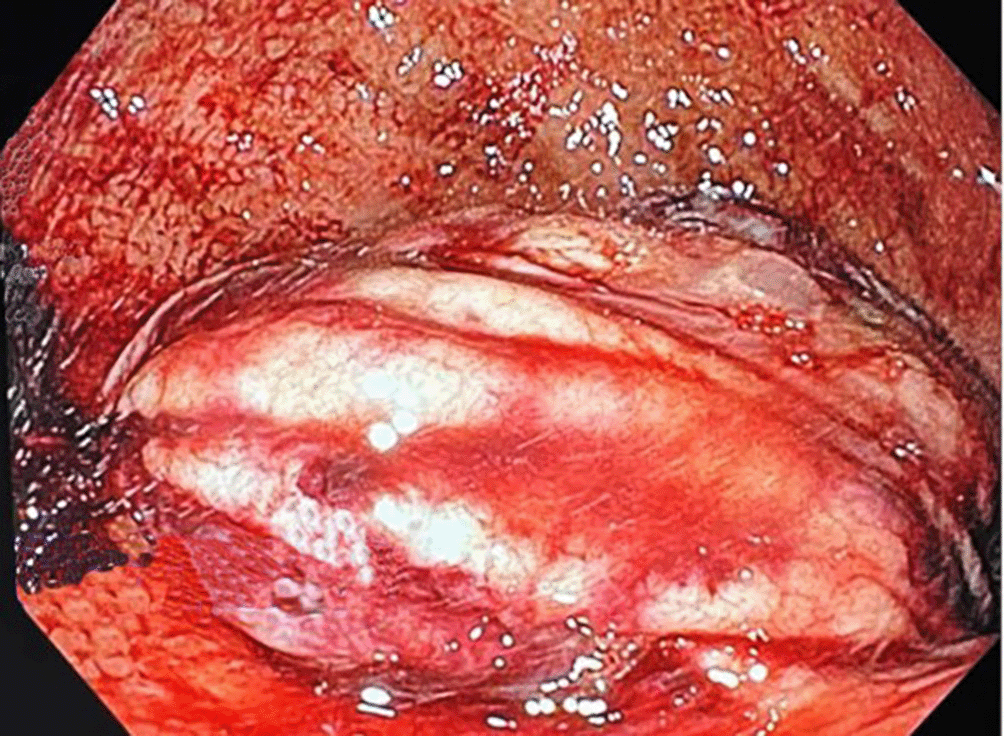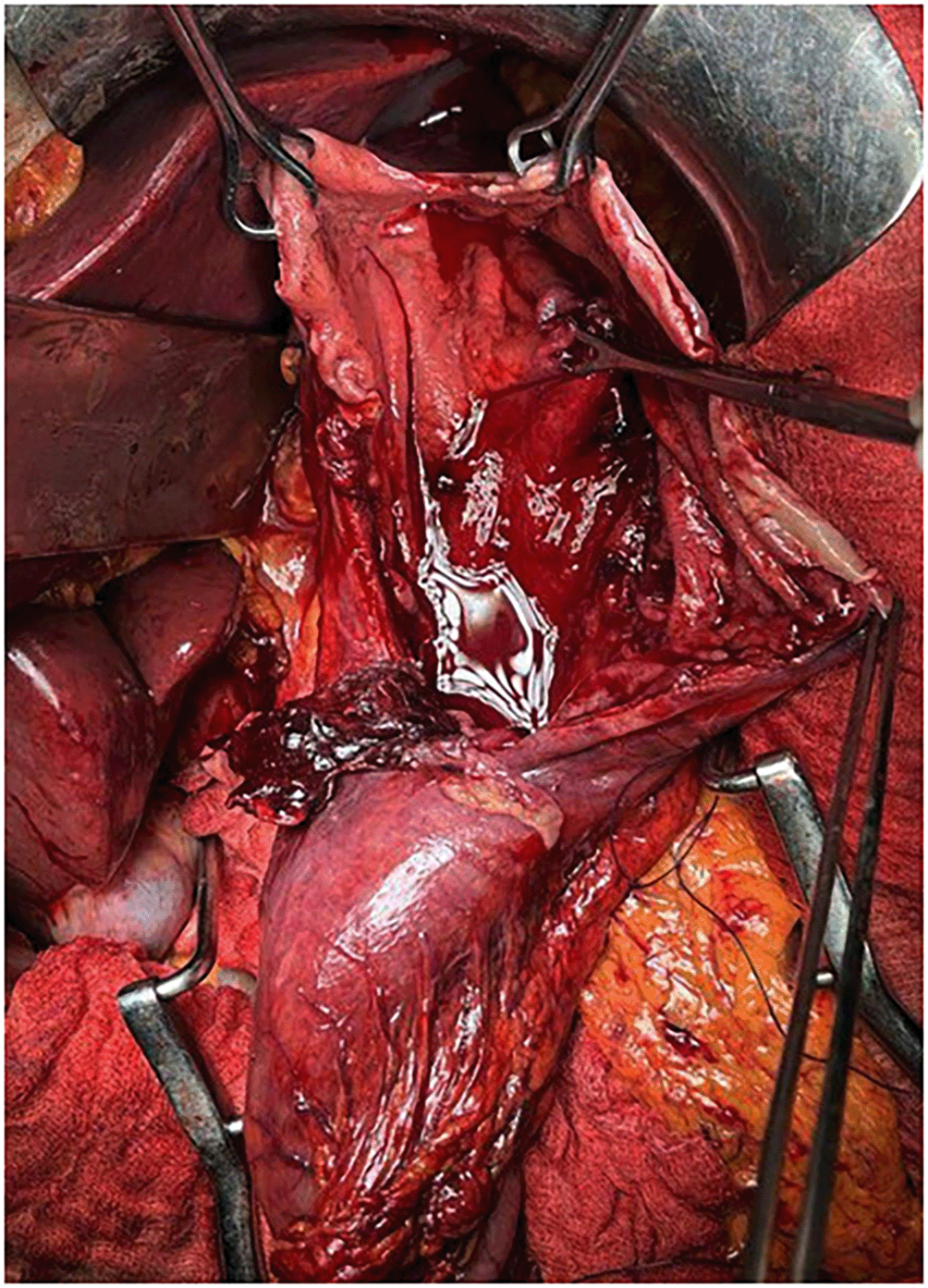Keywords
Gastric intramural hematoma; Upper gastrointestinal bleeding; Spontaneous hemorrhage; Partial gastrectomy; Surgery; Case report.
Spontaneous gastric intramural hematoma (GIH) is an exceptionally rare cause of upper gastrointestinal bleeding. We report the case of a 57-year-old man with no significant medical history who presented with hematemesis, melena, and hemodynamic instability. Upper endoscopy revealed a large submucosal hematoma with active bleeding. Despite endoscopic hemostasis and supportive management, hemorrhage persisted, requiring emergency partial gastrectomy. Histopathological examination confirmed submucosal hemorrhage without evidence of malignancy or vascular malformation. The patient had an uneventful postoperative recovery. This case underscores the importance of considering spontaneous GIH in the differential diagnosis of unexplained upper gastrointestinal bleeding and highlights the role of timely surgical intervention when endoscopic therapy fails.
Gastric intramural hematoma; Upper gastrointestinal bleeding; Spontaneous hemorrhage; Partial gastrectomy; Surgery; Case report.
Gastric intramural hematoma (GIH) is an uncommon entity characterized by hemorrhage within the submucosal or muscular layers of the gastric wall. It accounts for less than 1% of all causes of upper gastrointestinal bleeding.1 Most cases are secondary to trauma, anticoagulant use, or endoscopic procedures.2,3 Spontaneous cases, in the absence of any precipitating factors, are exceedingly rare.4 This report follows the CARE (CAse REport) guidelines and describes a massive upper gastrointestinal hemorrhage due to spontaneous GIH requiring surgical intervention after failed endoscopic therapy.5
A 57-year-old male with no prior medical or medication history presented to the emergency department with hematemesis, melena, and severe epigastric pain. On admission, he was hypotensive (85/55 mmHg) and tachycardic (120 bpm). Abdominal examination revealed epigastric tenderness without peritonitis. Laboratory investigations showed a hemoglobin level of 7.2 g/dL (baseline 13.4 g/dL) with normal coagulation parameters. The patient received aggressive fluid resuscitation and transfusion of four units of packed red blood cells.
Urgent endoscopy demonstrated a large submucosal hematoma on the posterior wall of the gastric body with active oozing ( Figure 1). Endoscopic hemostasis with epinephrine injection and clipping was attempted but failed to control bleeding. A contrast-enhanced CT was not performed due to the patient’s unstable condition. Given the persistence of bleeding and hemodynamic instability, the patient underwent emergency exploratory laparotomy. A large intramural hematoma involving the gastric body was identified ( Figures 2 and 3). Partial gastrectomy with primary reconstruction was performed ( Figure 4). Histopathology revealed extensive submucosal hemorrhage without evidence of neoplasia or vascular malformation. The postoperative course was uneventful, and the patient was discharged on postoperative day 8. At 3-month follow-up, he remained asymptomatic with no recurrence of bleeding.



Gastric intramural hematoma is a rare but recognized cause of upper GI bleeding. It is usually secondary to trauma, anticoagulation, or endoscopic injury.1,2 The spontaneous variant, as seen in this case, remains extremely uncommon. The presumed mechanism involves rupture of submucosal vessels with accumulation of blood between the gastric layers.6
Clinical presentation typically includes hematemesis, melena, and epigastric pain. Endoscopy may mimic subepithelial lesions, varices, or tumors.7 Contrast-enhanced CT, when feasible, helps differentiate hematoma from other masses by showing a non-enhancing, hyperdense lesion.8
Management depends on the patient’s stability and the underlying etiology. Conservative treatment may suffice for stable patients, particularly those with reversible causes such as anticoagulant therapy.9 However, in the presence of massive bleeding or persistent hemodynamic instability, surgical management becomes mandatory.10 Interventional radiology, such as arterial embolization, may represent an alternative if available and the patient is stable enough. In our case, persistent hemorrhage despite endoscopic therapy and transfusions necessitated partial gastrectomy, which was both diagnostic and therapeutic.
This case adds to the very limited literature on spontaneous GIH requiring surgery and underlines the diagnostic challenge of differentiating it from submucosal tumors.
Spontaneous gastric intramural hematoma should be included in the differential diagnosis of upper gastrointestinal bleeding, even in the absence of classical risk factors. While conservative management may be effective in stable cases, prompt surgical intervention is lifesaving when endoscopic therapy fails or instability persists.
Written informed consent for publication of this case and accompanying images was obtained from the patient. Ethical approval was not required for this single case report in accordance with institutional guidelines.
All relevant supporting materials, including the completed CARE checklist, are openly available in Zenodo.22. CARE checklist for “Spontaneous Gastric Intramural Hematoma Case report”. https://doi.org/10.5281/zenodo.17409686 .11
Data are available under the terms of the Creative Commons Zero “No rights reserved” data waiver (CC0 1.0 Public domain dedication).
| Views | Downloads | |
|---|---|---|
| F1000Research | - | - |
|
PubMed Central
Data from PMC are received and updated monthly.
|
- | - |
Provide sufficient details of any financial or non-financial competing interests to enable users to assess whether your comments might lead a reasonable person to question your impartiality. Consider the following examples, but note that this is not an exhaustive list:
Sign up for content alerts and receive a weekly or monthly email with all newly published articles
Already registered? Sign in
The email address should be the one you originally registered with F1000.
You registered with F1000 via Google, so we cannot reset your password.
To sign in, please click here.
If you still need help with your Google account password, please click here.
You registered with F1000 via Facebook, so we cannot reset your password.
To sign in, please click here.
If you still need help with your Facebook account password, please click here.
If your email address is registered with us, we will email you instructions to reset your password.
If you think you should have received this email but it has not arrived, please check your spam filters and/or contact for further assistance.
Comments on this article Comments (0)